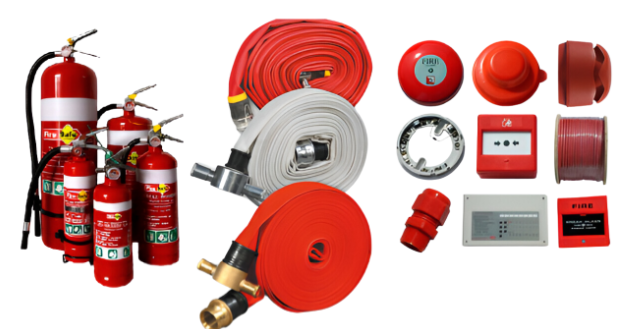
Fire Safety Equipments: Important Tools for Protecting Property
Fire safety equipments is important. It protects property from dangerous fires. Designers create these tools and devices to detect, prevent, and stop fires. These tools provide a first defense until emergency services arrive. Knowing the types of fire safety equipment and their uses can greatly save you from fire risks. You also need to know how to maintain them. This article gives a full overview of fire safety gear. It focuses on their importance, use, and maintenance.
Importance of Fire Safety Equipments
Fires can start suddenly. They spread fast, causing much damage and creating serious dangers for life. Effective fire safety equipment plays an important role in the following:
- Early Detection: Smoke alarms and heat detectors can guess early fire. This system allows for timely removal and mediation.
- Fire Suppression: Equipment like fire extinguishers, sprinklers, and fire blankets helps to control fires. They cover fire before the fire grows.PPE, such as fire-resistant clothing and breathing equipment, protects people. They shield them from heat, smoke, and toxic gases. They do this during removal or firefighting. To obey fire safety regulations is mandatory. This means installing and maintaining fire equipment properly. It applies to residential, commercial, and industrial buildings. It is for legal obedience and safety.
Types of Fire Safety Equipment
1. Smoke Alarms and Detectors
- Smoke alarms are an important tool for fire early detection. It provides a loud warning to helpers to cover the fire. There are several types of smoke alarms:
- Ionization Smoke Alarms: This one is a great tool for detecting fast-flaming fires.
- Photoelectric Smoke Alarms: It's more responsive to slow, smoldering fires.
- Dual Sensor Alarms: Both ionization and photoelectric technologies are used for wide detection.
- Proper installation is important. This alarm system should be placed on every part of a home. Regular testing and battery replacement are also important for maintaining its functionality.
2. Fire Extinguishers
- Fire extinguishers are essential for tackling small fires. They are divided based on the type of fire they can extinguish:
- Class A: For ordinary firings like wood, paper, and cloth.
- Class B: This is designed for flammable liquids like grease, gasoline, and oil.
- Class C: For electrical fires.
- Class D: For flammable metals.
- Class K: For kitchen fires involving cooking oils and fats.
- ABC extinguishers are multi-purpose. These can handle most types of fires found in homes and offices. Proper training is mandatory in this emergency. Regular maintenance checks are important to ensure they working properly when needed.
3. Fire Sprinkler Systems
- Fire sprinkler systems are automated. It is designed to detect and control fires. They control damage and provide time for shifting. There are several types:
- Wet Pipe Systems are the most common type. They store water in the pipes. The water is released when heat activates the sprinkler heads.
- Dry Pipe Systems: Pipes are filled with pressurized air. They release water only when a fire is detected. They're suitable for cold places where pipes might freeze.
- Pre-action systems require a two-step process to activate. This reduces the risk of accidental discharge.
- Deluge systems release water from all sprinkler heads at once. It is used in high-danger areas.
- Regular inspections and maintenance are important. It ensures these systems work in an emergency.
4. Fire Blankets
Fire blankets are non-combustible. Fire blankets stop small fires by preventing oxygen. They can be very helpful in kitchen fires. They can also be used to suppress fire when a person catches fire in their clothes. Fire blankets should be readily available. everyone should know how to use fire blankets.
5. Emergency Lighting and Signage
Emergency lights and exit signs provide directions and routes visible during a fire. They work well even if power fails. These systems are regularly tested to check they are working properly at all times.
6. Personal Protective Equipment (PPE)
PPE is important for firefighters or help in shifting. Some important components include:
- Fire-Resistant Clothing: These are made from materials that can stand against high temperatures.
- Breathing Apparatus: Provides clean air in smoke-filled environments.
- Fire Helmets and Gloves: Protect against heat and falling debris.
Maintenance of Fire Safety Equipment
Proper maintenance of fire safety equipment is important to its effectiveness. Regular inspections, testing, and servicing are crucial. They keep the equipment in prime working condition. Here are some general maintenance tips:
- Smoke Alarms: Test monthly and replace batteries at least once a year. Replace the entire unit every 10 years.
- Fire Extinguishers: Inspect monthly for any damage or pressure loss. Have them professionally serviced annually.
- Fire Sprinkler Systems: Conduct regular inspections and testing as per local regulations. Address any issues immediately.
- Fire Blankets: Check regularly for signs of wear and replace if damaged.
- Fire Doors: Ensure they close properly and are not obstructed. Inspect seals and hinges regularly.
- Test emergency lighting and signage often. This is to ensure they work, especially during power outages.
- PPE: Regularly inspect and replace any damaged equipment to ensure maximum protection.
Summary is here
Fire safety equipment is important. It is part of the fire prevention plan. Early detection devices, like smoke alarms, are important. Fire tools, like fire extinguishers and sprinkler systems, are also important. They protect lives and property. We must understand how these tools work, and how to maintain them. This ensures they are ready to perform when needed most. Investing in Proper fire safety equipment is worth it. Maintaining it perfectly can greatly reduce the harm fires cause.
.png)
